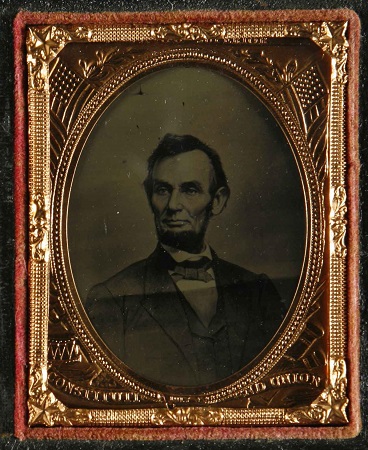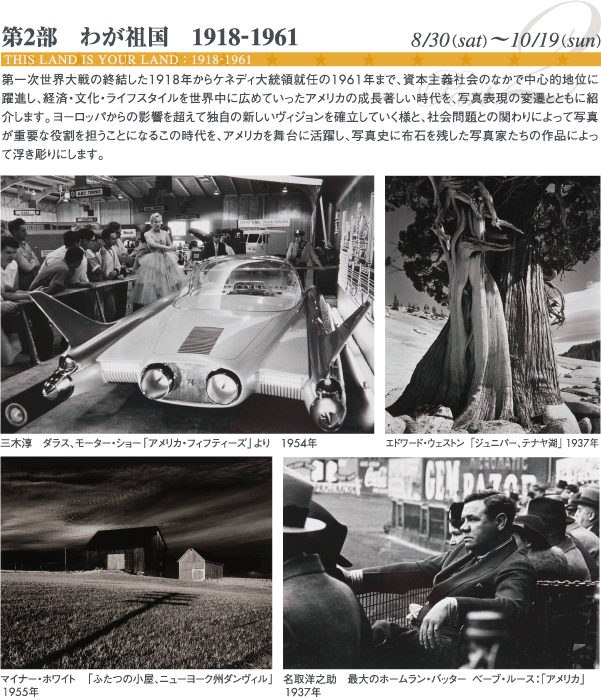
Part 1 The Star-Spangled Banner
Mathew Brady’s Studio, Title Unknown (Portrait of Abraham Lincoln), c.1860
Visions of America
Part 2 This Land is Your Land
Aug. 30—Oct. 19, 2008
- Aug. 30—Oct. 19, 2008
- Closed Monday(if Monday is a national holiday or a substitute holiday, it is the next day)
- Admission:Adults ¥500/College Students ¥400/High School and Junior High School Students,Over 65 ¥250
The United States has been a world leader in photography from its pioneering days through the present, but its influence was especially great during the twentieth century. That nation has also been crucially important as both a creative setting and a subject for not only American but also European and Asian photographers.
Visions of America, an exhibition in three parts from the collection of the Tokyo Metropolitan Museum of Photography, introduces many types and styles of photography from the United States, from nineteenth-century daguerreotypes to contemporary work. Selected from the 24,000 photographs in the museum's collection, these works are being exhibited by period. As the series unfolds, the Visions of America exhibition presents not only a view of the history of the United States since its foundation but also the multi-layered nature of its culture, with its complex relationships between the global and the local.
The second part of this exhibition, This Land Is Your Land: 1918-1961, introduces American photography and its many stylistic changes during a crucial period in American history, from the end of World War I in 1918 to the inauguration of John F. Kennedy as president in 1961. During those years of dramatic growth, the United States acquired a central position within capitalist societies, and American business, culture, and lifestyles spread around the world. Through the work of U.S.-based photographers who are recognized for their signal contributions to the history of photography, this exhibition underscores both their achievements in transcending European influence to establish a new, independent vision and the crucial role that photography played with respect to social issues during that period.
Highlights of Visions of America, Part II
Section 1:American Modernism
After World War I, the United States had risen to world leadership; it was time to develop its own national style of photography. Pictorialism, which the magazine Camera Work and the Photo-Secession movement had espoused, was, by the late 1910s, out of step with the times; American photographers aimed towards a new mode of expression, a style for the age of technology.
Shedding Pictorialism’s soft focus, the new style utilized clear, crisp images, sharp lines with clearly defined edges, and the beautiful shades of black, white, and gray that photographic paper can produce. The age of Straight Photography had arrived.
With Alfred Stieglitz serving as mentor to the standard-bearers of that new age, Paul Strand, Charles Sheeler, and Edward Steichen applied their fresh vision to capture the vitality of the modern city. On the west coast, Edward Weston and Ansel Adams, among the organizers of organizers of Group f.64, focused on the vast natural beauty of America.
These new modes of expression also were given full play in advertising photography, in the skilled hands of Ralph Steiner, Paul Outerbridge, Jr., and Victor Keppler, for example.
In 1937, the Bauhaus, which had been forced to close in Germany, was reestablished in Chicago. There Harry Callahan, Aaron Siskin, Nathan Lerner, and Yasuhiro Ishimoto played a key roles in building a vigorous culture of photography in the Midwest. In the 1950s, as photographers such as Minor White combined the stylistic heritages of Steiglitz, Weston, and Adams with spiritual metaphors derived from East Asian thought, American photography continued to thrive, with burgeoning stylistic variety.
Section2:The Golden Age of Illustrated Magazines
In 1936, HenryLuce, who was quick to grasp the power of themedia, launchedLife magazine. Its success touched offa boomin illustratedmagazines in theUnited States thatspread throughout the world.
Life highlighted its photo essays, inwhich it would usea set ofphotographs to tell the story, to communicate the content of the article. Excellent photographs were thus essential to Life’s success. The photographers whose work graced the pages of Life were pioneering photojournalists of great talent, including Margaret Bourke-White, Robert Capa,W. Eugene Smith,David Seymour, Carl Mydans, andJunMiki.
Growing demand for high quality photographs began spreading rapidly throughout the world. Tomeet that need, in 1947 Robert Capa, Henri Cartier-Bresson, and their colleagues founded their own photo agency, Magnum.
Fashion magazines such as Harper’s Bazaar and Vogue also employed excellent photographers such as Martin Munkacsi, Richard Avedon, and Irving Penn, as well as talented art directors such as Alexey Brodovitch and Alexander Liberman. Together, they created a fresh photographic style, raising the print media to new heights inwhat has been called their golden age.
Section3:DocumentaryPhotography
The New Deal was a set of measures the U.S.government devised to counter unemployment in the wake of the Great Depression, which struck in 1929. One of the New Deal projects, the Farm Security Administration (FSA), also had the unintended effect of energizing documentary photography in America. The main FSA goals were to move destitute farmers with smallholdings, tenant farmers, and sharecroppers onto land from which they would be able to make a living and to provide the necessary financial support to rebuild their lives. To secure funding for that program, the FSA needed to document themiserable conditions in which such farm families were living and to communicate their plight to the general voting population.
The FSA thus needed powerfully persuasive photographs. To acquire them, it hired photographers such as Walker Evans, Ben Shahn, and Dorothea Lange. Their work for the FSA was published in illustrated magazines,exhibitions,and other venues.
The government was well aware that work of signal artistic value would be effective in bringing the American people to a shared awareness of social issues. Indeed, the documentary photographs produced by theFSA includemany outstandingworks of art. Among the FSA photographers,WalkerEvans is particularly known for capturing images with universal impact and for the enormous influence he exercised over the next generation of photographers.
People who believed in the persuasive power of photographywere also drawn to participation in the Photo League, whichwas founded inNew York in1936. The Photo League developed into educational institution for the study of photography asa visual means of expressing one’s own views of events affecting society. Avictim of the “Red Scare” tactics employed by McCarthyism after World War II, the Photo League was forced to disband in 1951, but itsmembers’activities have beena major formative influence on Straight Photography in NewYork.


![チラシ1[pdf]](http://topmuseum.jp/upload/4/382/thums/2008_008_b.png)